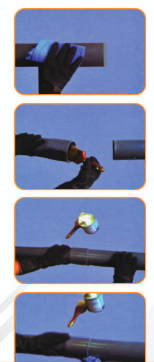Transportation and storage
One of the most important features of plastic pipes made of U.P.V.C is that it is strong and light, and its specific gravity is equivalent to the specific gravity of cast iron. Therefore, transporting this type of pipe is easier than transporting other pipes such as metal pipes or made of asbestos cement and the like, so the following must be followed:
01
Attention must be given to the process of emptying plastic pipes and lowering them gradually and not throwing them on the ground all at once.
02
It is not permissible to place pipes in large piles, especially during hot weather times of the year, as this results in distortion of the pipes at the bottom of the pile, making it difficult to connect them.
Pipes.
03
In long-term storage, special shelves must be provided for the pipes. If this is not possible, wooden boards 75 cm wide must be used at a distance of one meter between each.
Two plates for pipes with a diameter of 160 mm or more.
04
In long-term storage, special shelves must be provided for the pipes. If this is not possible, wooden boards 75 cm wide must be used at a distance of one meter between each.
Two plates for pipes with a diameter of 160 mm or more.
05
If pipes of different diameters are stored together in the same shelves, larger pipes must be placed
Measured below.
06
For temporary storage at the work site, the floors on which the pipes are stored must be level and free of stones.
07
when
Unloading requires gently rolling the pipes onto wooden boards, and it is not permissible to throw them one on top of the other or on an unpaved surface in the absence of a crane or winch.
08
In storage, the storage surfaces must be of sufficient width and at an angle of inclination to prevent direct sunlight during its rotation axis from east to west.
Instructions for installing U.P.V.C pipes in gaskets
- The (pipe tail) is inserted into the head (without the rubber ring) and a circular mark is placed to determine the overlap distance between the head and the tail:
The rubber ring and the inner surface of the pipe head cavity are cleaned well, Figure No. (1). - To easily install the ring in the head cavity, you must follow the steps shown in the drawing, Figure No. (2).
The beveled end (tail of the pipe) is cleaned to remove any stuck objects or grease with cleaning liquid, then the ring is placed in a cavity in the shape of No. - The beveled part is painted with soapy liquid or vegetable grease, and a small amount of the same liquid is applied to the outside of the rubber ring only in a circular and precise manner to facilitate the installation process.
- The head and tail are placed in one straight line and pushed in one motion to complete the installation process.
- For large sizes more than 280 mm, a screwdriver is used to insert the tail of the pipe in the head

Instructions for installing U.P.V.C pipes with adhesive
- The tail of the pipe is inserted into the head and a circular mark is placed to determine the overlap distance between the head and tail.
- The end of the pipe is sanded with a suitable file, especially in the case of cutting pipes at the work site, Figure No. 3
- The head and tail of the pipe are cleaned well with a piece of clean, dry cloth.
- Leave the adhesive on well before use.
- The adhesive is applied with a brush suitable for the diameter of the pipe in one direction on the tail of the pipe and inside the head.
- The tail is inserted into the head of the pipe with the full overlap distance specified by the mark on the tail of the pipe, taking care not to move the pipe in a circular direction.
d The distance of interference - The line’s operation is tested 24 hours after the gluing process is completed.
- Be careful not to leave the adhesive material open so that it does not dry out.



